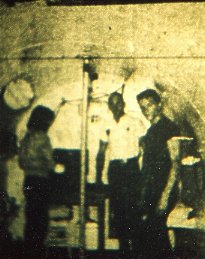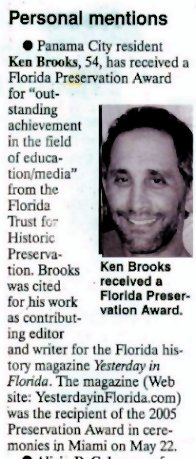FALLOUT SHELTERS: The Selling of Doomsday...
World tensions are running high: America faces down a foreign foe as its citizens brace for an uncertain future.
Headlines from today's Panama City News Herald? Not quite.
The date is October, 1961, and the planet holds its breath as American and Soviet tanks face each other, muzzle to muzzle, along Berlin's east-west border. Then, on Oct. 30, the Russians detonate a 50-megaton nuclear bomb in the skies over the Pacific; a test--or is it a warning? (A weather station in nearby Apalachicola, Florida, actually records the blast's shock waves, which last five minutes).
Fallout fever grips America. Newspapers across the nation--including the News Herald--run Fallout Tracking Maps, tracing the bomb's radioactive cloud as it treks eastward across the Pacific towards North America.
Overnight, it seems, a new phrase enters the nation's consciousness: Fallout shelter.
Nationally, plans are made to equipt schools with underground shelters, and students crouch under desks during air-raid drills--as if a school desk provided protection! Neighborhoods begin planning Fallout Shelter Clubs--a doomsday version of time-share.
Here in Panama City, The Bomb Shelter Company opens for business on West Highway 98, near present-day Zoo World. "A Russian attack," company manager John Carroll tells the News Herald, "would likely be at night, so you would probably be at home. A fallout shelter would be your means of existing."
A seven-by-six foot, six-person model--welded from three-sixteenth-inch steel--sells for $1300.
When the Bay County Fair opened October 30, visitors viewed a model shelter displayed at the fairground's main entrance.
"An air filter system complete with exhaust and manually operated centrifugal blower is standard equipment," the News Herald reports. "Accessory kits provide radiation counters, different types of toilets, and motorized blowers."
Fallout Mania reached a peak in October 1962 during the Cuban Missile Crisis. Within a year, however, the two superpowers had retreated from the brink of atomic Armageddon and signed their first-ever nuclear arms treaty, forever banning above-ground bomb testing.
By then, Fallout Mania had subsided. Panama City's Bomb Shelter Company closed, leaving the fallout shelter--like the hula hoop and the twist--a cultural curiosity of the early sixties.
______________________________
Panama City News Herald, 10-22-2000
______________________________
* * *
The Shoe-Fitting Fluoroscope: Better living through radiation...
The great Japanese Tsunami of March 2011 may have sparked radiation fears from Hermosa Beach to Hiroshima to Honolulu to Hermosa Beach, but the fact is, by the time most Baby Boomers were out of grade school they'd already been exposed to unnecessary doses of Vitamin R. And you can blame Mom for that.
Throughout the 1930s and into the 1950s virtually every shoe store (and shoe department) in America came equipped with a shoe-fitting X-ray unit, commonly known as a fluoroscope.
No self-respecting shoe store could afford to be without one. After all, wasn't modern science supposed to transform our lives for the better? If you were in the footwear game, that meant offering customers perfect-fitting shoes -- scientifically guaranteed. Smart merchants placed their miracle machines front and center on a specially-lit raised platform to increase its allure.
Typical shoe store fluoroscopes were housed in a four- foot vertical wooden cabinet with an opening at the bottom into which customers placed their tootsies. At the top of the cabinet were three viewing ports: one for the sales clerk, one for the child, and one for...well, usually Mom, if it was your day to buy shoes.
Real magic, it seemed, was conjured inside that cabinet, where sat a lead-shielded x-ray tube and a fluorescent screen. Customers trying on shoes placed a foot inside and -- voila! A peek into the viewing port would reveal a glowing image of the bones of the feet and the outline of the shoe! Savvy salespeople encouraged kids to wiggle their toes as the x-rays worked their magic.
Magic? Really?
Not exactly. The discovery of x-rays, by German physicist William Roentgen in 1895, prompted Thomas Edison to devote a section of his Menlo Park lab to their study and to place trusted assistant Clarence Dally in charge. Edison's research came to an abrupt and grisly halt in 1904 when Dally, 33, died after both his arms required amputation -- the first fatality in America associated with radiation research.
Obviously, x-rays' death-dealing dangers were known even then, a danger further illuminated by the popularity of wrist watches with radium dials. By 1920, over four million Americans owned one. Before the decade was over, however, radium dial painters were dying in crazy numbers; many had routinely licked their paint brushes to create a sharper point.
Still, the spectral rays continued to fascinate.
During WWII, Boston physician Dr. Jacob Lowe developed an x-ray generating tube in order to better match soldiers' boots to their feet. When the war ended in 1918 Lowe converted his machine for use in shoe stores and secured a patent the following year. It was 1927, however, before X-Ray Shoe-Fitter, Inc. of Milwaukee began mass-producing fluoroscopes under the Adrian and Simplex brand names.
During the 1930s, Depression-deprived American consumers were sold on the idea that fluoroscopes would provide them with better-fitting, longer-lasting shoes. As prosperity returned, shoe retailers pitched the notion that shoes should be fashionable and change with the season. (Obviously, women didn't need much arm-twisting to accept the idea that every outfit required its own matchinfg footwear).
And so the fluoroscope thrived.
By the early-1950s there were over 10,000 such machines in stores across America. Blithly unaware moms were schlepping their precious boomers to multiple stores, trying on multiple pairs at each stop. But their risk paled in comparison with that of shoe salespeople who -- day after day -- typically placed their hands inside the box to "feel the fit" of every shoe.
The machines themselves could be dangerously unstable; a miscalibration could result in doses large enough to bathe every customer in the store with dangerous levels of radiation. X-Ray Shoe-Fitters, Inc provided no training to retailers, either; the machines (cost: $700 in 1950) went straight from box to salesfloor.
Even as the fluoroscope wowed Eisenhoer-era moms and kids, the demise of shoe-fittng devices was at hand.
The aftermath of the August 1945 atomic attacks at Hiroshima and Nagasaki provided the world with gruesme evidence of radiation's evils and generated a post-war shift in public perception: modern science could kill, too.
In 1949 an editorial in the Journal of the American Merdical Association warned of the dangers of shoe-fitting fluoroscopes, citing skin and bone damage and stunted growth in young children. The U.S. Public Health Service followed with dire warnings of dermititis, malignancy, cataracts, sterility. In 1953 Pediatricians Magazine joined the cause.
In 1957, Pennsylvania became the first state to ban the shoe-fitting fluoroscope. In 1970 the ban extended to 33 states; by the mid-1970s strict regulations in the remaining states caused retailers to discard their x-ray shoe-fitters, many in local dumps -- where they continued to radiate.
As late as 1981, a shoe-fitting fluoroscope was still in use in a downtown department store in a remote corner of southwest West Virginia; shocked store owners immediately relinquished the machine to the U.S. Food and Drug Association.
The sad fact remains that we may never know how many illnesses and premature deaths were caused by these harmless-looking devices. Sadder still, no evidence ever existed that fluoroscopes provided a better fitting shoe than that old stand-by from the 1920s, the Brannock Device -- that silver-and-black gizmo with the sliding levers -- which is still used in shoe stores today.
If nothing else, shoe-fitting fluoroscopes provided a mirror that reflected America's evolving expectations regarding the miracles of modern science. In the early years of the 20th Century, the explosion of scientific knowledge promised a future of undreamed ease and convenience. But time revealed a shockingly unexpected dark side of science, where man's tinkering with x-rays and atoms dealt disease, destruction, and unimaginable death.
Today, the x-ray shoe-fitter seems a remote artifact from another, more naive age, where children giddily wiggled their toes under an iridescent glow that seemed to light a path to a brighter future.
Who knew then what evils lay silently afoot?
--Ken Brooks
skip to main |
skip to sidebar





The Shoe-Fitting Fluoroscope




The Brannock Device
Two articles: FALLOUT SHELTERS...and THE SHOE-FITTING FLUOROSCOPE
Here's two-for-the-price-of-one. FALLOUT SHELTERS: THE SELLING OF DOOMSDAY...and THE SHOE-FITTING FLUOROSCOPE: BETTER LIVING THROUGH RADIATION. By Ken Brooks.



PHOTO GALLERY...
Top and center:
Newspaper ads, 1961.
Above:
Bay County Fair-goers tour a
shelter set up inside the fairgrounds.
Top and center:
Newspaper ads, 1961.
Above:
Bay County Fair-goers tour a
shelter set up inside the fairgrounds.

The Shoe-Fitting Fluoroscope




The Brannock Device